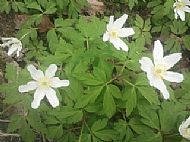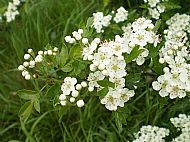 Greater Stitchwort. In April the Greater Stitchwort or Shirt Buttons can be found along every hedge in the area. |
|
 Honeysuckle. A true sense of summer when you breath the heady scent of Honeysuckle. |
|
 Wood Anemone From late March and into April this little flower adorns Birch Grove.
Photo,Stephanie Murran. |
|
 Bluebell. Everyone must be familiar with the Bluebell and the white and pink varieties.In decline in some places due to the invasive Spanish Bluebell.
|
|
 Black Thorn. Heralds the spring nicely, in abundance in the area. Like the Hawthorn it is much mentioned in folklore.
|
|
 Hawthorn The Hawthorn or May blossom, steeped in folklore and food for many species, abundant in hedges around the Wick. |
|
 Cowslip. There are a few Cowslips on the Wick but sparse. |
|
 Gorse. Common on on the Heathland on the Wick and cheers up the gloomiest of days. The seeds get spread by Ants. |
|
 Bugle Grows in the wet woodland behind the Wick, April to August. |
|
 Ground Ivy All year round on the Wick but flowers most April to June. |
|
 Ground Ivy A clump of Ground Ivy. |
|
 White Dead Nettle Common on the Wick and close up as handsome as anything cultivated. |
|
 Red Dead Nettle Sometimes carpets a large area in pinkish purple, it is seen here with the Common Daisy. |
|
 Lesser Celadine I have seen these in flower in late December but March is normal. Patches here and there along the hedges on the Wick. |
|
 Primrose. Here and there in the hedges on the Wick. |
|
 Broom Broom is a common shrub on Heathland,flowers in May and is one of the food plants for the Green Hair streak Butterfly. |
|
 Broom A more general view of Broom. |
|
 Borage. Borage is an escape from cultivation and has become naturalised in the wild.However insects love it and that way it adds to the well being of the diversity. |
|
 Common Vetch Wides in the grassland on the Wick. |
|
 Yellow or Common Toad Flax. A fairly common wild Antirrinum. Flowers, late May to September. |
|
 Red Clover. A common enough but very attractive wild lower on the Wick. |
|
 Yellow Flag. The Yellow Flag or Water Iris occurs in the wet woodland behind the Wick. |
|
 Foxglove. A magnificent Foxglove on the Wick. |
|
 Yarrow. A common meadow flower, you can sometimes find a pink variety. It is said that Achilles used it to treat wounds made by iron weapons. |
|
 Dog Rose. A common wild rose, the hips are a rich source of vitamin C. |
|
 Goats Beard. The magnificent seed heads of the Goats Beard, they can get to around 3 inches in diameter. |
|
 Rosa Spirosa. This grows in the wet woodland and doesn't mind the shade. Scarcer than the Dog Rose. |
|
|
| |
|
|